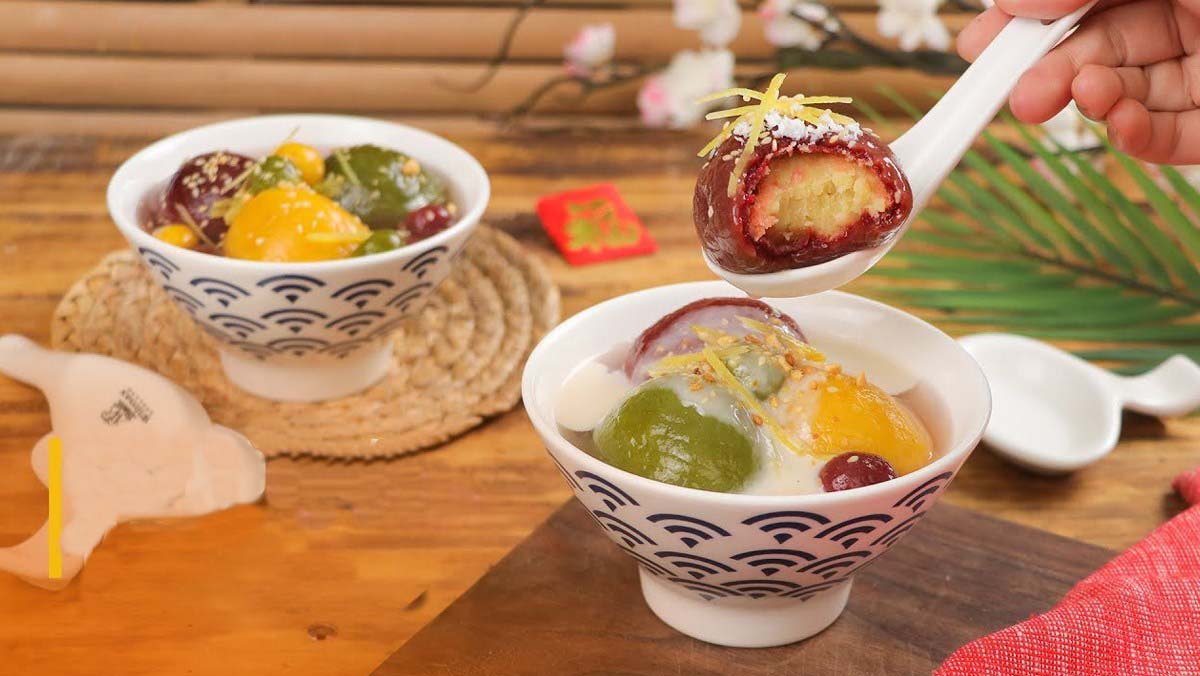Why Vietnamese street food is unique
Food experience is a sensory experience. The unique combination of flavors, textures, and aromas sets it apart from other cuisines around the world. Whether it is the famous Pho, Banh Mi, or the lesser-known delicacies such as Bun Cha, Bo Kho, and Com Tam, every dish tells a story of Vietnam's rich history and culture.
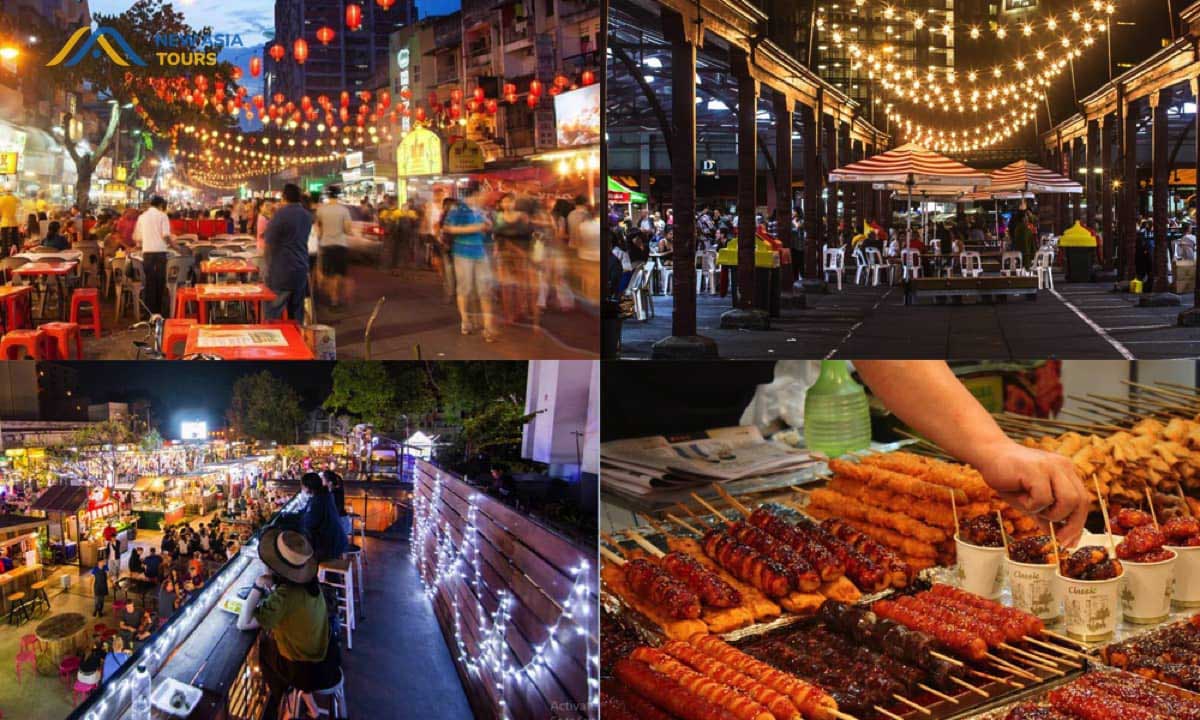
Vietnam street food
Abundance and balance: Vietnamese street food combines different flavors and textures to create delicious, affordable, and convenient food options. The country's tropical and abundant environment provides the ideal conditions for a variety of tropical ingredients and endless culinary creativity, harmoniously combining the colors and flavors of local produce. With the use of fresh herbs, spices, and ingredients, Vietnamese street food offers a depth of flavor that is hard to match.
Available and affordable: Vietnam street food is an essential part of daily life in Vietnam. From the bustling markets and busy corners of the cities to the quiet alleys of small towns, Vietnamese street food can be found everywhere. Street vendors or mobile food stalls are easily accessible throughout the day with reasonable prices for all.
Cultural experience: The food is cooked right in front of customers, ensuring its quality and authenticity. You will have the opportunity to witness street chefs skillfully prepare Vietnamese-style dishes with pre-processed ingredients right in front of you and present them to you. Moreover, Vietnam street food also carries stories of the time and culture.
In the next part, we will explore unique Vietnamese street foods that have made Vietnam cuisine gain popularity across the globe.
Phở – A beginner’s guide
In 2007, Pho appeared in the Oxford Dictionary publication. Phở is a unique combination of elaborate fragrant broth paired with tender slices of beef or chicken, smooth rice noodles, and many fresh herbs. The Vietnam street food is often served with condiments such as lime, pickled garlic, pepper, and chili sauce for you to adjust the dish. With its savory and heartwarming taste, it is no surprise that Phở is loved by so many. Phở is truly one of Vietnam’s most popular dishes and a satisfying culinary treasure that can be enjoyed by all.
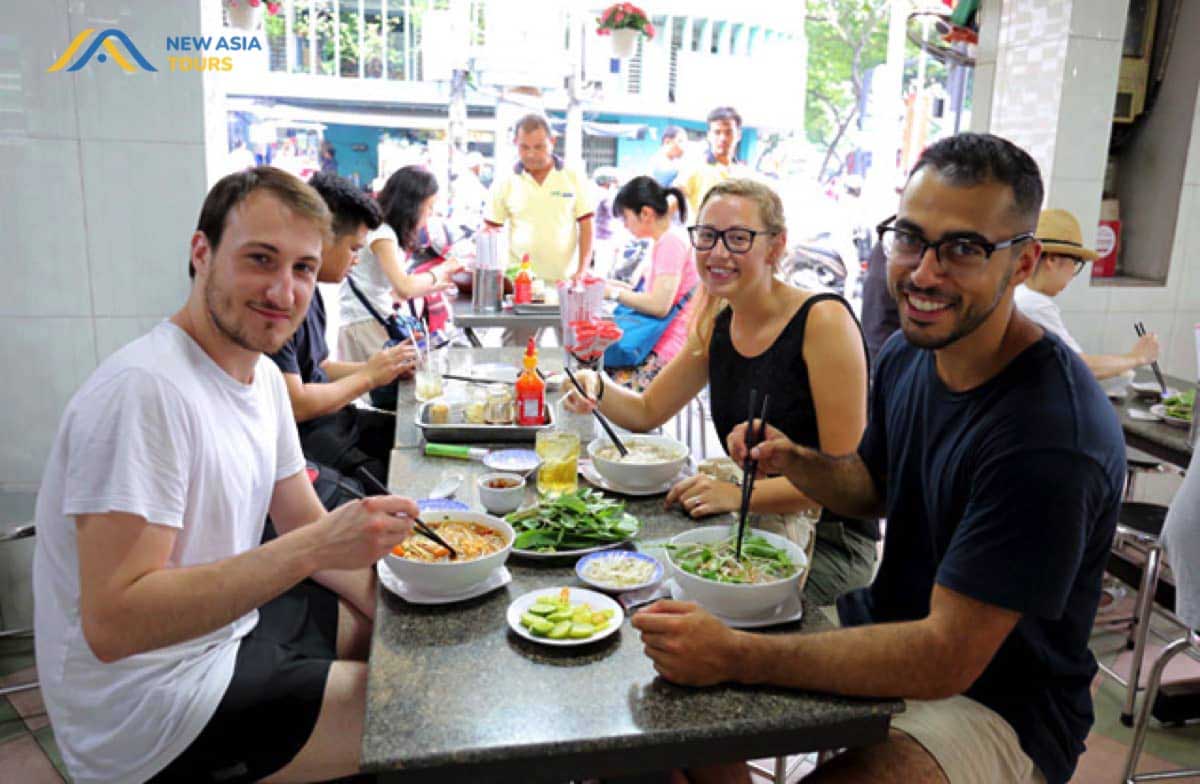
Having warm bowls of Phở
Phở is said to appear in Northern Vietnam in the late 19th or early 20th century. It quickly became a popular option on the street to serve a large population because of its delicious taste, easy-to-eat nature, and nutritional value. This dish can be adapted to suit your dietary preferences if you are vegetarian or vegan.
You can find this delectable dish in any corner of Vietnam. You should try this Vietnam street food in North Vietnam to try the most original flavors. Famous Phở brands in Vietnam are:
-
Phở Thìn (13 Lo Duc, Hai Ba Trung, Hanoi)
-
Phở Bát Đàn (49 Bat Dan, Hoan Kiem, Hanoi)
-
Phở 10 Lý Quốc Sư (10 Ly Quoc Su, Hoan Kiem, Hanoi)
-
Phở Đán (117 Bac Ninh, Nguyen Du, Nam Dinh)
-
Phở Tao (228 Dien Bien, Loc Hoa, Nam Dinh)
The price of a bowl of phở can vary, but on average it costs between 25,000 - 100,000 VND (about 1 - 3,4 USD) depending on the region and type of restaurant.
Bánh mì – The ultimate sandwich
Following Phở, Bánh Mì is the second Vietnamese term to be added to the Oxford Dictionary in 2011. Banh mi is a scrumptious, filling sandwich that makes for a quick and satisfying meal. What sets this Vietnam street food apart is the combination of the crispy French-style baguette with a variety of fresh and savory fillings. The main ingredients for the filling are diverse, usually divided into three categories: meat (pork, chicken, beef, pate, egg, patty, sausage), vegetables (pickled vegetables, herbs), and sauce (chili sauce, mayonnaise, tomato sauce).
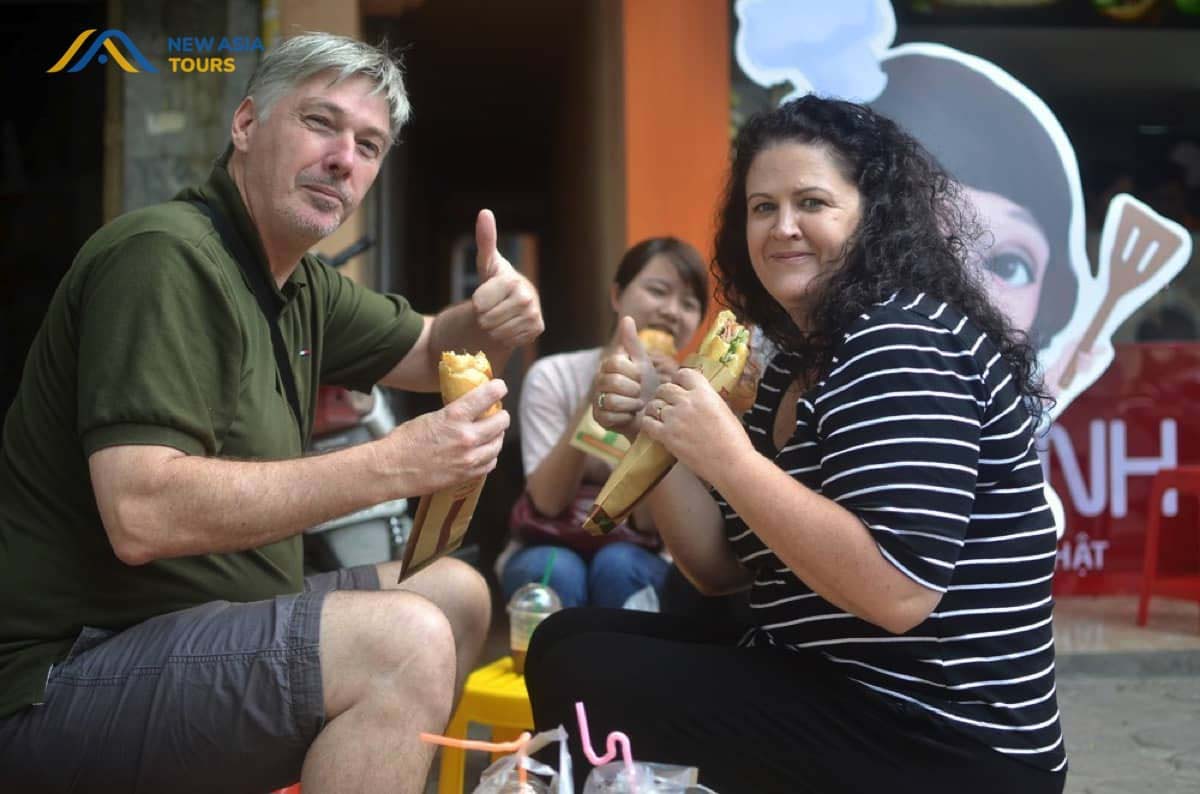
A compact loaf of Bánh Mì can be eaten anywhere
Vietnamese Bánh Mì is said to have originated during the French colonial period in the 19th century. At that time, the French brought white bread to Vietnam. Due to the differences in resource characteristics and tastes of the Vietnamese people, the bread was improved into a unique Vietnamese version. Since then, Bánh Mì has become a popular and favored dish not only in Vietnam but also in many other countries around the world.
One of the best things about this Vietnam street food is the experience of holding the compact and lightweight sandwich in your hand and eating it anywhere you want. You can enjoy it on the spot while standing amid vibrant Vietnamese markets and street vendors.
The cities in Vietnam that have famous and distinctive Bánh Mì include Hanoi, Ho Chi Minh City, Danang, Hoi An, and Da Lat. Here are some addresses you should visit and try:
-
Bánh Mì Phúc (9 Yet Kieu, Hai Ba Trung, Hanoi)
-
Bánh mì Huỳnh Hoa (26 Le Thi Rieng, District 1, Ho Chi Minh City)
-
Bánh Mì Phượng (2B Phan Chu Trinh, Hoi An)
-
Chicken Bánh Mì Cô Chi (Phan Dinh Phung - Phan Chau Trinh - Le Loi intersection, Da Nang)
-
Meatball Bánh Mì Hoàng Diệu ( 26 Hoang Dieu, Ward 5, Da Lat)
The prices of this Vietnam street food can vary depending on the location and type. In general, you can expect to pay between 15,000 - 40,000 VND (about 0,6 - 1,7 USD) for a loaf of Bánh Mì with full fillings, making it an affordable and delicious option for budget travelers and foodies alike.
Bún chả – Grilled pork noodle soup
Bún Chả is a Vietnam street food made up of grilled pork which is served alongside a dish of vermicelli rice noodles, a bowl of savory dipping sauce, and a basket of fresh herbs and vegetables. The pork is marinated in a rich and flavorful mixture of fish sauce, sugar, garlic, and pepper before being grilled to perfection over hot coals. The result is a smoky and savory flavor that is difficult to resist.

US former president Obama eats Bún Chả in his Vietnam visit in 2016
In addition to the pork, this Vietnam street food can also include various other elements such as crispy spring rolls or grilled meatballs. The herbs and vegetables served alongside the dish typically include lettuce, herbs like mint and cilantro, as well as bean sprouts, cucumber, green papaya, and carrots. In 2022, Bún Chả showcased in the Platinum Jubilee Cookbook of the UK proudly features 70 mouth-watering recipes from British embassies around the world that are served on visits by the British Royal Family.
This Vietnam street food originated in Hanoi, the capital city of Vietnam. Nowadays, many reputable restaurants and street vendors serve up this delicious meal throughout Vietnam, with some of the most notable spots being found in Hanoi:
-
Bún Chả Hương Liên - also known widely as Bún Chả Obama since the US president’s visit in 2016. It can be found at 24 Le Van Huu, Hanoi, or 14, Alley 59, Lang Ha, Hanoi.
-
Bún Chả Tuyết (34 Hang Than, Ba Dinh, Hanoi)
-
Bún Chả Đắc Kim (1 Hang Manh, Hoan Kiem, Hanoi)
-
Bún Chả Sinh Từ - the brand has 9 branches in Hanoi. You can find one convenient for your visit on Google Maps.
A typical serving of Bún Chả can cost anywhere from 30,000 - 150,000 VND (about 1,2 - 6,4 USD) depending on the location and quality of the ingredients.
Gỏi cuốn – Vietnamese spring rolls
Gỏi Cuốn is known as Vietnamese fresh spring rolls. The Vietnam street food became a popular dish that has gained widespread recognition for its flavorsome taste and healthy ingredients. These light and refreshing rolls are traditionally made with rice paper and filled with a combination of rice vermicelli, fresh herbs, vegetables, and protein such as egg, shrimp, or pork. The dish is served with a side of fish sauce or peanut sauce, which complements the rolls perfectly.
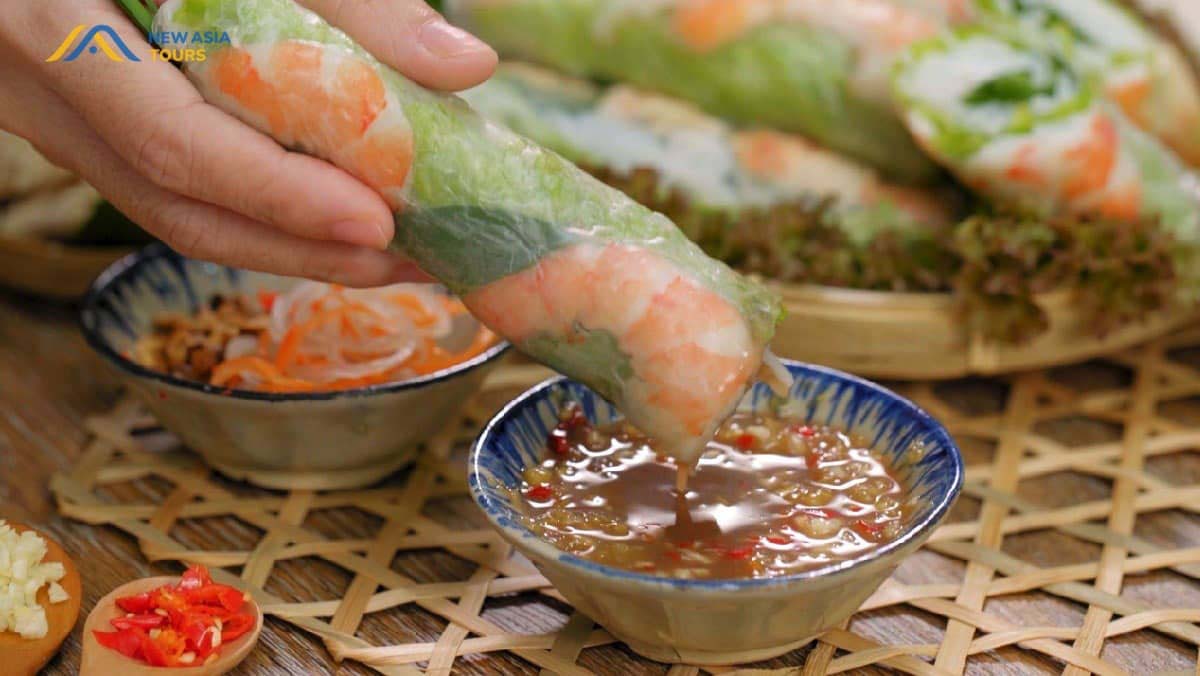
Dipping Gỏi Cuốn in the chili garlic fish sauce
Many sources that claim that Gỏi Cuốn originated from the Southern region of Vietnam. This is an easy-making Vietnam street food, requiring only wrapping ingredients in rice paper and it can be easily enjoyed anywhere. Restaurants can either pre-roll them or place the ingredients on a tray for you to wrap according to your preferences. Famous Gỏi Cuốn eateries in Vietnam can be found in the cities of Ho Chi Minh and Hanoi:
-
Gỏi Cuốn Lê Văn Sỹ (359/1/9A Le Van Sy, Ward 13, District 3, Ho Chi Minh City)
-
Gỏi Cuốn Lạc Long Quân (424 Lac Long Quan, Ward 5, District 11, Ho Chi Minh City)
-
Gỏi Cuốn Hạnh (420A Hoa Hao, Ward 5, District 10, Ho Chi Minh City)
-
Gạch Quán (6C 21 Pham Ngoc Thach, Dong Da, Hanoi)
-
So Cuốn (76 Lo Duc, Hai Ba Trung, Hanoi)
At the end of 2019, Gỏi Cuốn was included in the top 50 most delicious dishes in the world as voted by CNN. The average price for a serving of this Vietnam street food varies depending on the location and the type of filling used. You can expect to pay around 30,000 to 50,000 VND (about 1,2 - 2,1 USD) per serving.
Explore more about ultimate guide to Vietnam!
Bún bò Huế – Hue’s Beef Noodles
Bún Bò Huế is a traditional Vietnamese noodle soup with its origins in the ancient capital of Hue, located in Central Vietnam. The cuisine of Central Vietnam stands out with a blend of spices and elaborate decoration. You will notice it when enjoying this Vietnam street food. Its hearty and spicy soup is made from beef bones and a variety of herbs and spices, resulting in a rich and flavorful broth that is known for its medley of sweet, savory, and spicy flavors.

A savory bowl of Bún Bò Huế
The soup is typically served with thinly sliced beef shank, pork knuckle or pork patties, and a wide rice noodle. It is also garnished with fresh herbs such as mint, cilantro, and chopped scallions, as well as thinly sliced onion and a sprinkle of chili flakes for extra heat.
The South China Morning Post magazine of Hong Kong once honored three Vietnam street food including Bún Bò Huế, Phở, and Bánh Mì in the top list of the most delicious breakfast dishes in Asia. Many restaurants throughout the country offer their versions of this classic soup. Some of the most popular restaurants include:
-
Bún Bò Huế O Phụng (14 Nguyen Du, Phu Cat, Hue)
-
Bún Bò Huế Ms. Tuyết (47 Nguyen Cong Tru, Hue)
-
Bún Bò Huế Ngự Uyển - the brand has many branches in Hanoi. You can find one convenient for your visit on Google Maps.
-
Bún Bò Út Hưng (6C Tu Xuong, Ward 7, District 3, Ho Chi Minh City)
As for the price, a bowl of Bun Bo Hue can range from approximately 40,000 - 70,000 VND (about 1.7 to 3 USD).
Bún Đậu Mắm Tôm - Fried Tofu, Vermicelli, And Fermented Shrimp Paste
Bún Đậu Mắm Tôm is a traditional Vietnamese dish consisting of vermicelli noodles (Bún), boiled pork, pig intestines, crispy spring rolls, fried tofu (Đậu), fried patties, cucumber, herbs, and a flavorful dipping sauce made from fermented shrimp paste (Mắm Tôm). The distinctive flavor is from the pungent shrimp paste that is mixed with fried oil, sugar, chili, lime juice, and sometimes garlic.

Bún Đậu Mắm Tôm is arranged nicely and deliciously.
If you are not used to eating shrimp paste for the first time, you can ask the restaurant to replace it with fish sauce. After eating this dish, it may leave a smell on your breath, so the restaurants will also give you a piece of chewing gum or mint candy to freshen your breath.
Bún Đậu Mắm Tôm is commonly found throughout Vietnam, particularly in Hanoi where it originated. The dish is affordable and can be found anywhere from street food vendors to upscale restaurants. Some popular locations to try this Vietnam street food include:
-
Bún đậu Cây Đa (235B Thuy Khue, Tay Ho, Hanoi)
-
Bún Đậu Hàng Khay ( 29 Hang Khay, Hanoi)
-
Bún Đậu Nghĩa Tân ( 104 C3, Nghia Tan, Cau Giay, Hanoi)
-
Bún Đậu Ngõ Nhỏ Phố Nhỏ (158 Pasteur, Ben Nghe, District 1, Ho Chi Minh City)
-
Bún Đậu Ngọc Hà (255 Le Quang Dinh, Ward 7, Binh Thanh, Ho Chi Minh City)
Recently, a Bún Đậu Mắm Tôm restaurant named "Mắm" has appeared on the streets of the US, attracting many diners and making it into the top 30 New York’s best restaurants by The New York Times. Prices for this dish there can range from 14 to 35 USD per serving for multiple people. In Vietnam, this Vietnam street food costs between 30,000 and 200,000 VND (about 1.3 to 8.5 USD) per serving.
Bánh tráng nướng – Grilled Rice Paper
Bánh Tráng Nướng is a popular Vietnam street food that originates from the Southern region of Vietnam. This tasty snack is made with rice paper, which is coated in a mixture of egg, butter, small shrimp, corn, green onions, sausage, minced pork, and sometimes cheese before being grilled over charcoal until crispy and golden. There will be chili sauce, tomato sauce, and mayonnaise put on it before serving to you. The resulting texture is uniquely flaky, and the flavors are a perfect balance of salty, savory, and slightly sweet.
This Vietnamese street food can easily be spotted on your travel streets in Vietnam. The appetizing and crispy texture combined with flexible features is part of what makes this snack such a beloved dish in Vietnam, with different regions and vendors putting their spin on the recipe.
Some of the best places to enjoy this delicacy in Vietnam include street vendors in Hanoi and Ho Chi Minh City, the coastal city of Da Nang, and the serene Da Lat City:
-
Bánh Tráng Nướng 111 Doi Can, Ba Dinh, Hanoi
-
Bánh Tráng Nướng 33 Chua Lang, Dong Da, Hanoi
-
Bánh Tráng Nướng 61 Cao Thang, Ward 3, District 3, Ho Chi Minh City
-
Bánh tráng nướng C002 (23/49 Dinh Tien Hoang, Ward 3, Binh Thanh, Ho Chi Minh City
-
Bánh Tráng Ms. Trang (K227 Hung Vuong, Hai Chau, Da Nang)
-
Bánh Tráng Kim Đà Lạt (65/22 Ham Nghi, Thanh Khe, Da Nang)
-
Bếp Đà Lạt (89 Hoang Hoa Tham, Ward 10, Da Lat)
-
Bánh Tráng Nướng 112 Nguyen Van Troi, Da Lat)
Prices can vary depending on location and vendor, but on average, Bánh Tráng Nướng is an affordable and satisfying snack that can be enjoyed for just a few thousand dongs per piece, from 15,000 - 30,000 VND (0,6 - 1,3 USD).
Bánh Giò - Vietnamese Rice And Pork Dumplings
Bánh Giò is a savory pastry made with rice flour. This Vietnam street food has a smooth jelly texture and is typically filled with pork, wood ear mushrooms, and vermicelli noodles. It is then wrapped in banana leaves and steamed to perfection. The aroma of the banana leaf and the blend of savory flavors make Banh Gio a widely favored and handy street food among Vietnamese. This Vietnam street food is often served with chili sauce and pickled cucumbers, sometimes sausage and boiled quail egg.
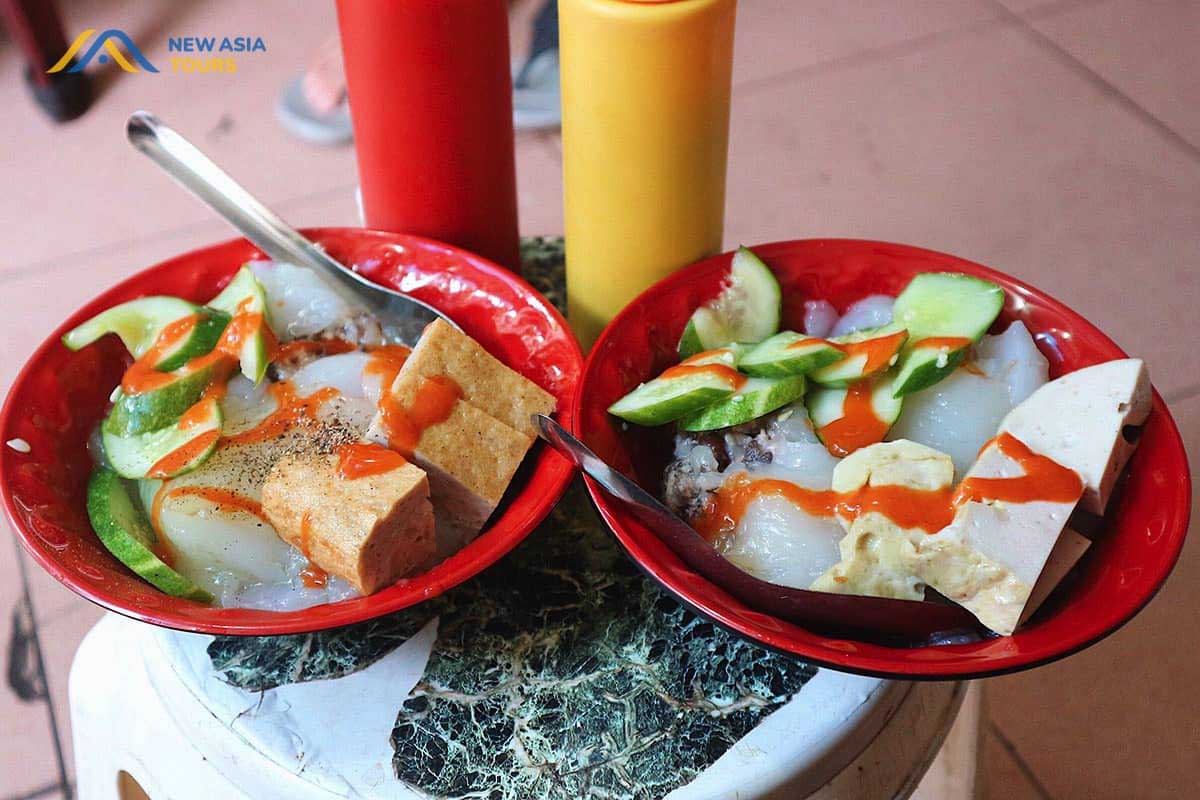
Full topping Bánh Giò
In Vietnamese society, Bánh Giò is considered a classic dish. It is used on many occasions, especially during Tet (Lunar New Year). The dish is believed to bring luck and peace to the family.
In terms of price, Bánh Giò is an affordable snack that can be found at street vendors across the country for around 10,000 - 20,000 VND (less than 1 USD). However, for the more adventurous foodies, many restaurants and eateries that specialize in this dish where you can experience the dish at its finest for around 25,000 - 50,000 VND (about 1 - 2 USD).
-
Bánh Giò Thụy Khuê (5 Thuy Khue, Tay Ho, Hanoi)
-
Bánh Giò Đông Các (33 Dong Cac, Dong Da, Hanoi)
-
Bánh Giò Mom Múp (No 93, Street 45, Ward 6, District 4, Ho Chi Minh City)
Cơm Tấm - Vietnamese rice with Grilled pork ribs
Cơm Tấm is a signature Vietnam street food that is beloved for its simplicity yet flavorful taste. Com Tam, translated as "broken rice", was originally considered a low-class option as broken rice grains were leftovers from the milling process. However, it has now become a popular dish that is highly recommended and enjoyed by everyone.
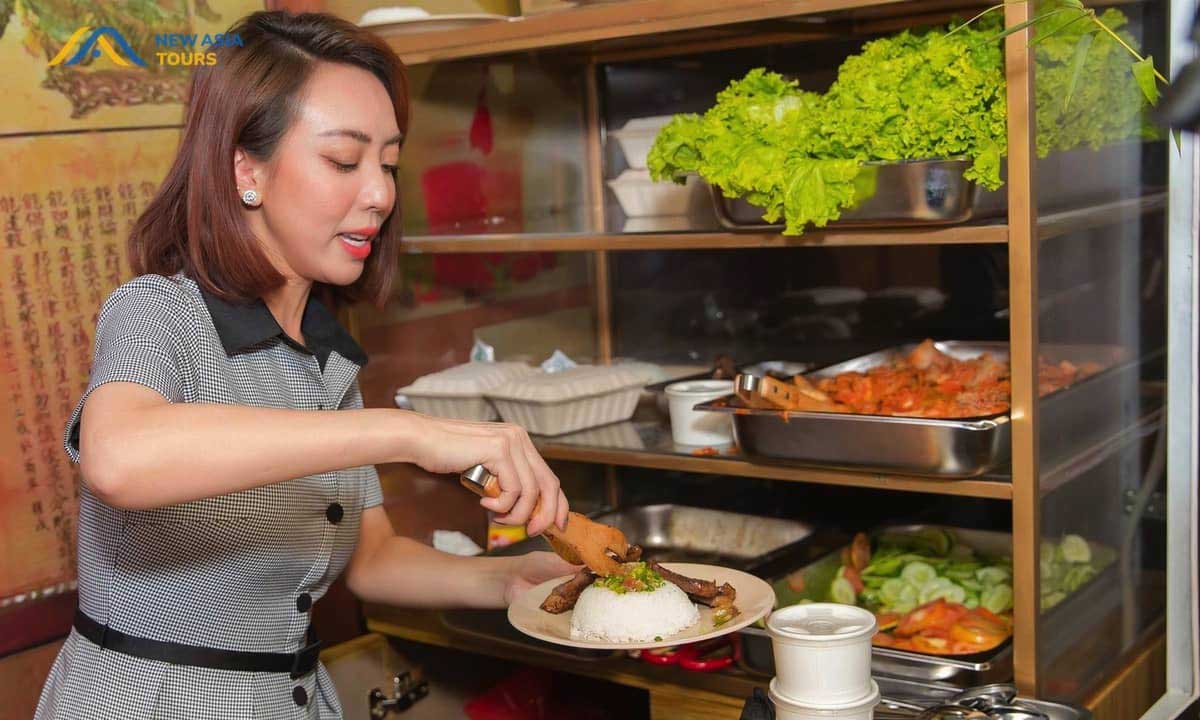
The owner prepares a dish of Cơm Tấm for customers using the ingredients laid out on the table
This Vietnam street food is usually accompanied by grilled pork chops, pork patties, shredded pork skin, fried egg, and steamed egg meatloaf. It is often served with a side of pickled vegetables, sliced cucumber, and a bowl of fish sauce, completing its unique flavor profile.
Although Cơm Tấm is widely served in Vietnam as a quick and complete meal choice, Ho Chi Minh City is considered the best place to indulge in this local delight. One of the best Cơm Tấm eateries:
-
Cơm sườn Ba Cường (263 Tran Quang Khai, Tan Dinh, District 1, Ho Chi Minh City)
-
Cơm tấm Bà Năm (34 Tan Canh, Tan Binh, Ho Chi Minh City)
-
Cơm tấm Nguyễn Văn Cừ (74 Nguyen Van Cu, District 1, Ho Chi Minh City)
-
Cơm tấm Tài (1 Nguyen An Ninh, Ward 14, Binh Thanh, Ho Chi Minh City)
The average price of this Vietnam street food ranges from VND 30,000 to VND 70,000, which is roughly around 1.3 - 3 USD.
Tips for venturing into Vietnamese street food
You can choose some of the names we have suggested above to try Vietnam street food. However, not all of these locations will be conveniently located on your limited-time itinerary, and not all of the places we do not suggest can not be the best. There are always some interesting surprises on a journey. Therefore, we have added some small tips below for your street food adventure that you can apply:
-
Look for busy stalls and eat where locals eat: The more people a food stall attracts, the better the food most likely is. Look for busy stalls with a line-up of locals. You can also ask locals where they like to eat street food. They often know the best places, they can recommend places locals like, and are more than happy to share their ideals.
-
Observe: Traditional street culture in Vietnam is quite open and pleasant. However, some places do not prioritize strict service standards. Therefore, observe and choose a restaurant that suits your preferences about decor, hygiene, cooking, and management methods. Nowadays, many restaurants and eateries value traditional unique culture while also emphasizing professionalism and service.
-
Try new things: Vietnamese street food is diverse and offers a range of dishes from savory to sweet. Don't be afraid to try new dishes and flavors that you have never tasted before.
-
Carry cash: Most Vietnamese eateries allow online payment, however, some street vendors in Vietnam only accept cash. So make sure to carry some small notes to avoid any inconvenience.
-
Be cautious with spices: Vietnamese street food is famous for its use of spices and chili peppers. If you are not used to spicy food, start with milder dishes and gradually work your way up to spicier options. Normally, chili sauce/slices are placed on the side for you to adjust on your own. Additionally, if you are a vegetarian, have allergies, or dislike certain ingredients, you can inform the restaurant staff while ordering.
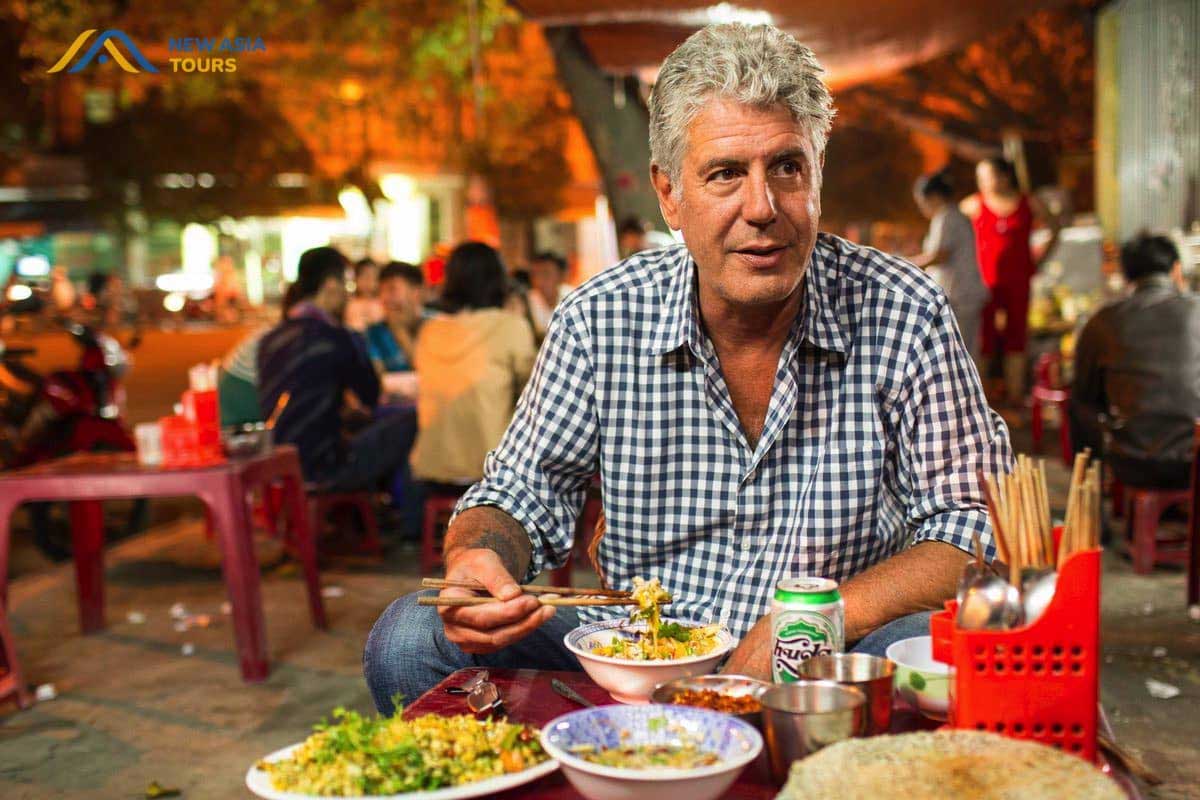
Try new things to explore Vietnam street food
During a food show interview in Seoul, Korea, when a YouTuber asked Gordon Ramsay "Where would you say is the No. 1 food destination?", the celebrity chef replied Laos, Vietnam, and Madrid. He said "Vietnam, the extraordinary melting pot of food. I fell in love, there is just such a humble approach to eating food.” The chef fell in love with Vietnamese cuisine and now is your turn to try and say what you think. Are you ready for your approach to the Vietnam street food world with all the information you have been told? If you need any further support on your Vietnam package tour, don't hesitate to contact New Asia Travel.




